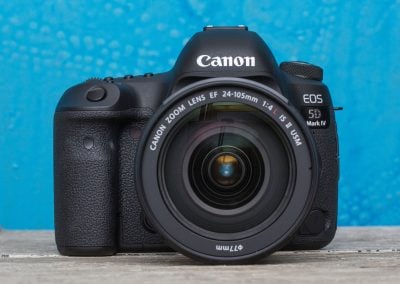Canon EOS 5D Mark IV review
-
-
Written by Gordon Laing
Quality
To evaluate the image quality of the EOS 5D Mark IV, I’m presenting three sets of results, one for resolution, one for noise and one for movie quality. In my Canon 5D Mark IV noise results lower on the page you’ll see how it compares against two key full-framers, the earlier EOS 5D Mark III and the mirrorless Sony A7r Mark II, all using the same Sigma 50mm ART lens – I won’t be offended if you skip to that straightaway! In my Canon 5D Mark IV movie quality results you’ll see how the 4k and 1080p quality compares to the Fujifilm XT2 and Sony A6300.
First though I’m making a different comparison, looking at the resolution of a daylight landscape scene. Since I already have a comparison with full-framers on the next page, I thought I’d make a different comparison here against an APS-C mirrorless camera, the Fujifilm XT2. I know they’re completely different cameras aimed at different photographers at different price points, but I’ve received a lot of requests to compare them, so here you go. Once again if you’d prefer my full-frame comparison using identical lenses, scroll down to my Canon 5D Mark IV noise results.
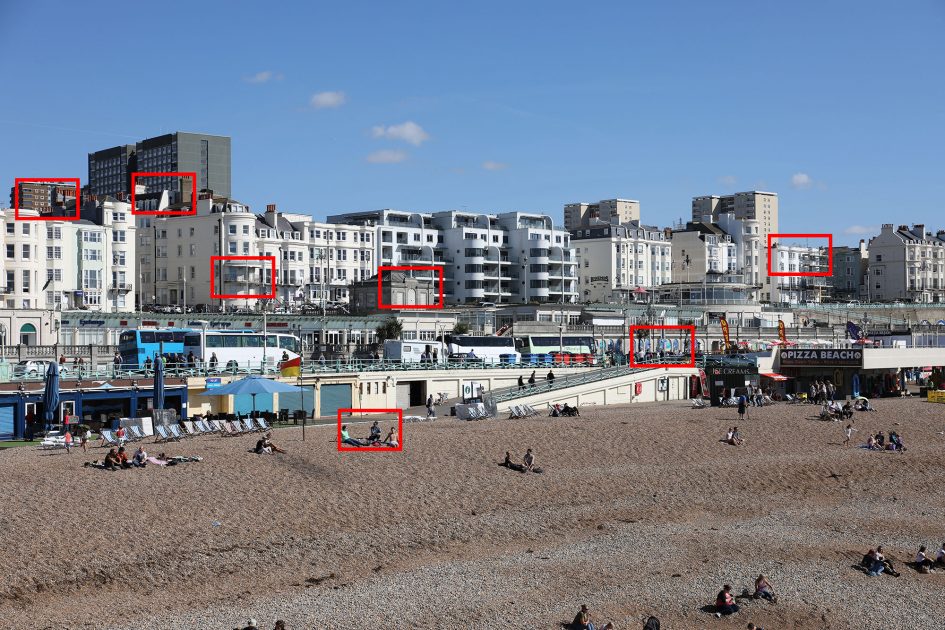
I took the scene above with the EOS 5D Mark IV fitted with the EF 24-70mm f4L IS USM lens, set to just over 55mm f8. For the Fujifilm XT2, I fitted it with the XF 35mm f2 prime lens, set to f5.6; the aperture values chosen represent sweet-spots for quality on both lenses. As for the choice of lenses, these were the ones supplied by the manufacturers and better than any other alternatives I had to hand. I would have preferred to use either zooms on both or primes on both (although getting the field-of-view to exactly match with primes would have been difficult). But in terms of quality, both lenses used are very good and at the aperture selected I don’t believe either are holding the bodies back. If you think this is an unfair test, skip to my Canon 5D Mark IV noise results where I used the same Sigma 50mm f1.4 ART lens on all three bodies.
At the time of writing, Adobe hadn’t yet released support for the 5D Mark IV RAW files, so I’m presenting a comparison of JPEGs straight out of camera; I will update this page with RAW results once the 5D IV is supported in Adobe.
So in the left column you’re looking at an APS-C body with a 24 Megapixel X-Trans sensor and on the right you’re looking at a full-frame body with a 30.4 Megapixel CMOS sensor.
Judging from the crops below I’d say both are resolving a similar amount of real-life detail – certainly there’s no visible benefit here to the extra 6 Megapixels of the EOS 5D Mark IV, nor its larger sensor, at least for low ISOs on the conditions of the day. If anything, the Fujifilm XT2 crops in the left column are a little crisper and more contrasty, due no doubt to Fujifilm’s in-camera processing defaults when using the standard Provia Film Simulation. I’m not surprised as Canon often reigns back the sharpening on its JPEGs using the Standard style, so once I get a chance to process the RAW files with the same settings, I’m expecting a similar playing field in terms of visible sharpness.
So an approximate draw here on the first page, but the really interesting test is lower on the page where I’ve compared the three full-framers with the same lens, allowing you to directly compare sensors and processing styles. Keep scrolling!

Above: Fujifilm XT2 and XF 35mm f2 at f5.6 (left), Canon EOS 5D IV and EF 24-70mm f4 at 55mm f8 (right)

Above: Fujifilm XT2 and XF 35mm f2 at f5.6 (left), Canon EOS 5D IV and EF 24-70mm f4 at 55mm f8 (right)

Above: Fujifilm XT2 and XF 35mm f2 at f5.6 (left), Canon EOS 5D IV and EF 24-70mm f4 at 55mm f8 (right)

Above: Fujifilm XT2 and XF 35mm f2 at f5.6 (left), Canon EOS 5D IV and EF 24-70mm f4 at 55mm f8 (right)

Above: Fujifilm XT2 and XF 35mm f2 at f5.6 (left), Canon EOS 5D IV and EF 24-70mm f4 at 55mm f8 (right)

Above: Fujifilm XT2 and XF 35mm f2 at f5.6 (left), Canon EOS 5D IV and EF 24-70mm f4 at 55mm f8 (right)

Above: Fujifilm XT2 and XF 35mm f2 at f5.6 (left), Canon EOS 5D IV and EF 24-70mm f4 at 55mm f8 (right)
Canon EOS 5D Mark III vs EOS 5D Mark IV vs Sony A7r Mark II noise
To compare noise levels in low light I shot the following still-life arrangement with the Canon EOS 5D Mark III, EOS 5D Mark IV and Sony A7r Mark II at each of their ISO sensitivities. I fitted each body in turn with the same Sigma ART 50mm f1.4 lens, set to f11, and used the same shutter speeds at each sensitivity. I disabled Auto lighting Optimiser on the Canons and Dynamic Range Optimiser on the Sony and used their standard picture styles and Auto White Balance. I shot all the images in RAW+JPEG mode and as soon as the Mark IV is supported in Adobe Camera RAW, I’ll present a comparison using identical processing settings. For now though, I’m presenting a comparison using the out-of-camera JPEGs, with the cropped region indicated by the red rectangle on the main image below; each is presented in the table below at 100%. Many thanks to Park Cameras UK for their support in making this comparison.
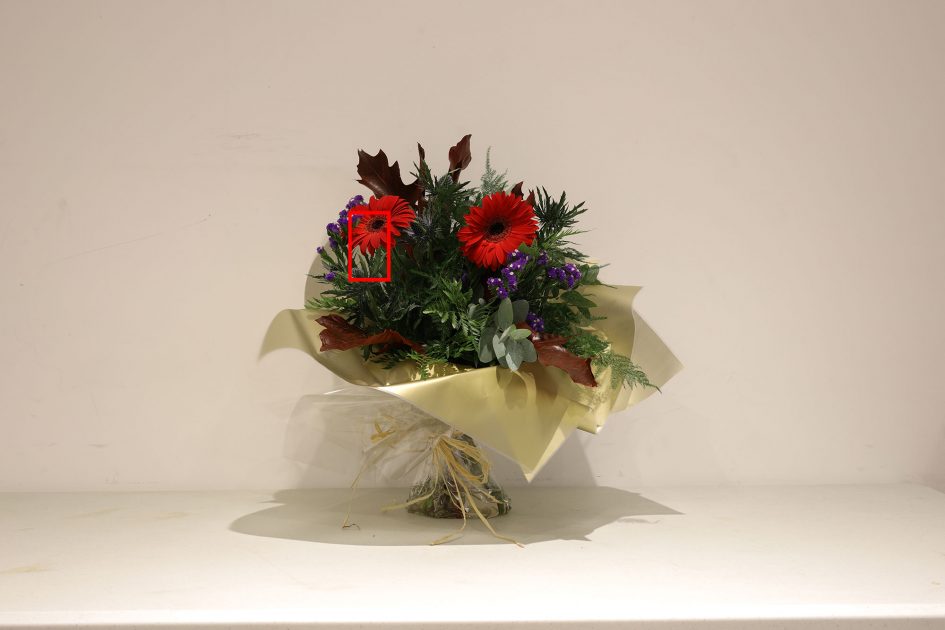
In the table below you’re looking at 100% crops made from three bodies with full-frame sensors, from left to right, the Canon EOS 5D Mark III, EOS 5D Mark IV and the Sony Alpha A7r Mark II. Each sports steadily higher resolutions of 22.3, 30.4 and 42 Megapixels respectively which means a fixed cropped box will show a steadily smaller area.
Judging the out-of-camera JPEGs below, I’d say between 50 and 1600 ISO, the EOS 5D Mark IV slightly out-resolves the Mark III and the A7r Mark II slightly out-resolves the 5D Mark IV. The difference between 22.3 and 30.4 Megapixels or between 30.4 and 42 Megapixels can be subtle, but pixel-peepers will notice it in certain areas. But the resolution difference between the 5D Mark III and Sony A7r Mark II is more striking. Meanwhile within this ISO range, I’d say all three are delivering fairly clean results with minimal noise artefacts.
At 3200 ISO and above, some noise begins to creep into the results, while the smearing effect of noise reduction can be seen in some areas, particularly in subtle tonal gradation. As the sensitivity increases, you’ll see detail gradually reduce in the petals and leaf veins, while speckles steadily increase in areas of flat colour. I’d say the 5D Mark IV starts to pull ahead of the 5D Mark III in terms of retained detail from 12800 ISO and above, which is a great result given the sensor packs more pixels into the same area – the benefit of newer sensor technology and different processing. But I’d also say Sony’s A7r Mark II remains slightly ahead of, or at worst looking very similar to, the EOS 5D Mark IV in this first comparison.
Of course here we’re comparing different sensors and different processing strategies. Once Adobe supports the 5D Mark IV, I’ll present a RAW comparison where all three will receive the same processing settings to really see what’s going on behind the scenes.
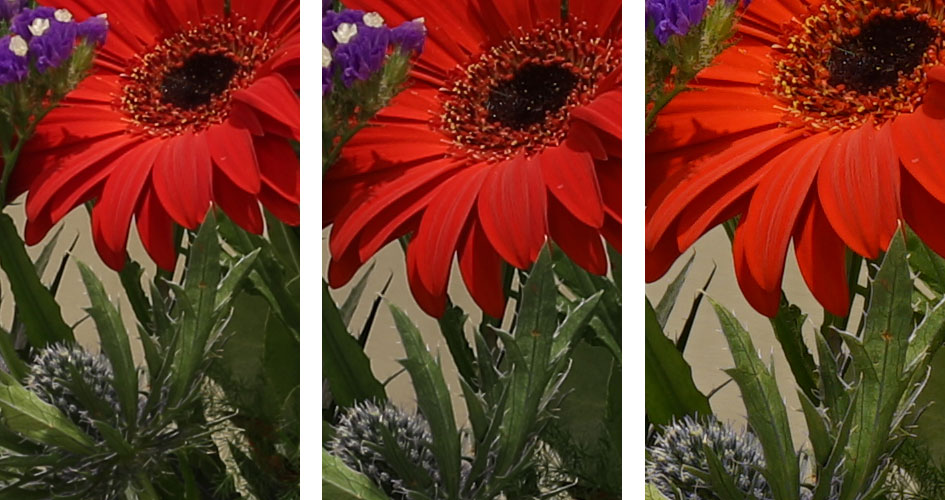
Above: Canon EOS 5D III (left), Canon EOS 5D IV (middle), Sony A7r II (right) all in JPEG at 50 ISO
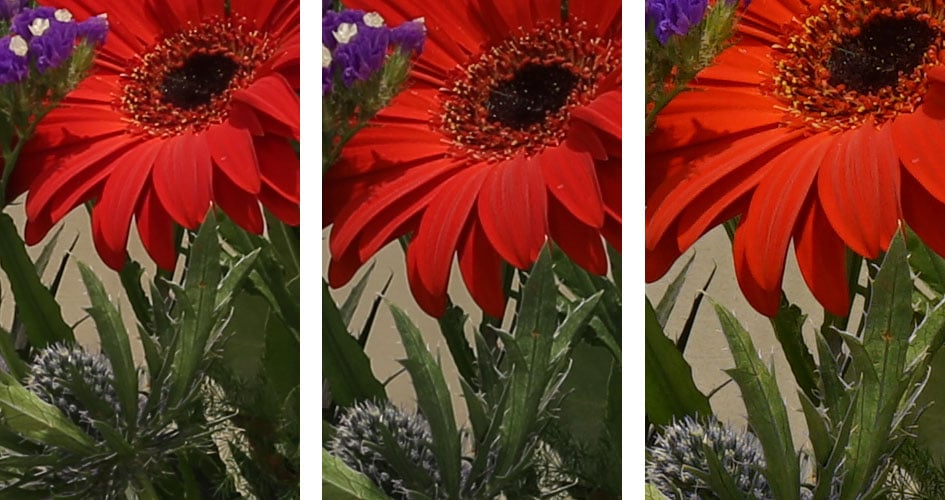
Above: Canon EOS 5D III (left), Canon EOS 5D IV (middle), Sony A7r II (right) all in JPEG at 100 ISO
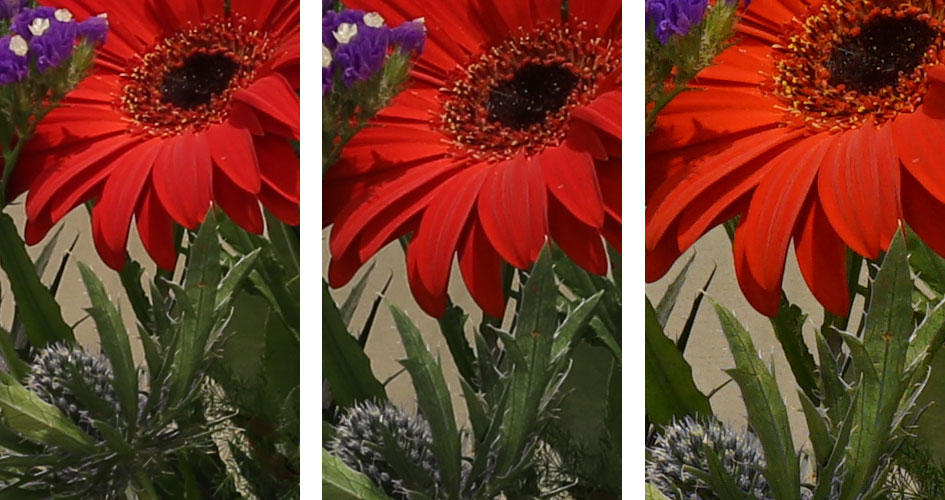
Above: Canon EOS 5D III (left), Canon EOS 5D IV (middle), Sony A7r II (right) all in JPEG at 200 ISO
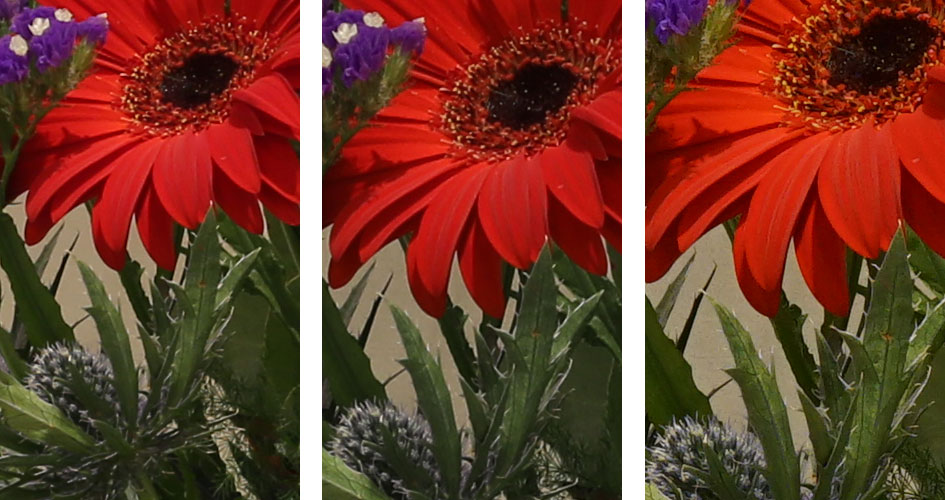
Above: Canon EOS 5D III (left), Canon EOS 5D IV (middle), Sony A7r II (right) all in JPEG at 400 ISO
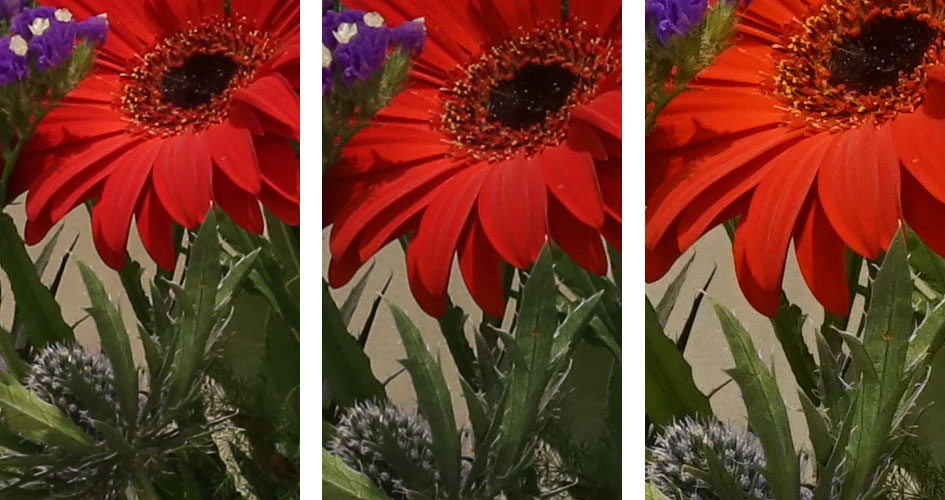
Above: Canon EOS 5D III (left), Canon EOS 5D IV (middle), Sony A7r II (right) all in JPEG at 800 ISO
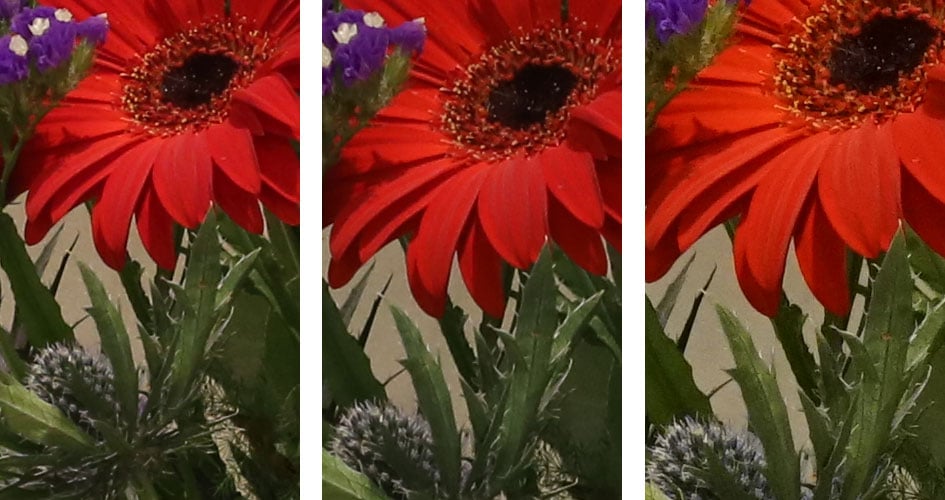
Above: Canon EOS 5D III (left), Canon EOS 5D IV (middle), Sony A7r II (right) all in JPEG at 1600 ISO
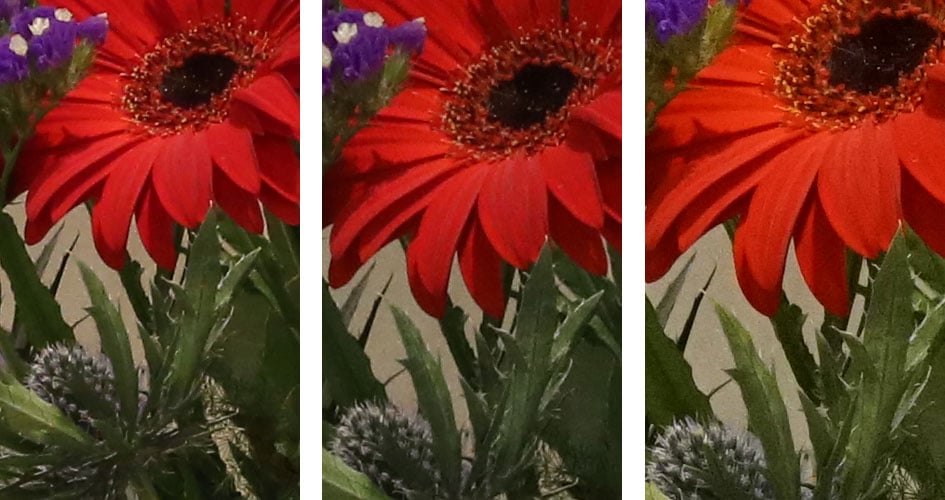
Above: Canon EOS 5D III (left), Canon EOS 5D IV (middle), Sony A7r II (right) all in JPEG at 3200 ISO
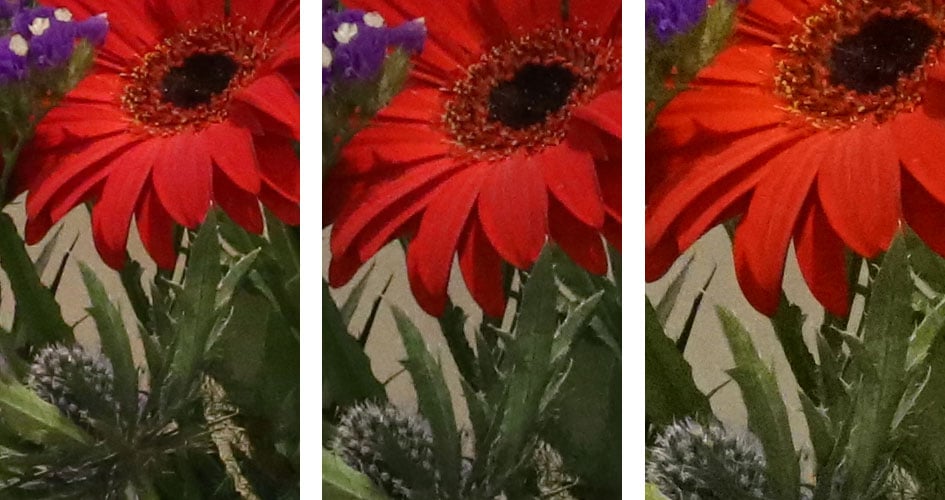
Above: Canon EOS 5D III (left), Canon EOS 5D IV (middle), Sony A7r II (right) all in JPEG at 6400 ISO
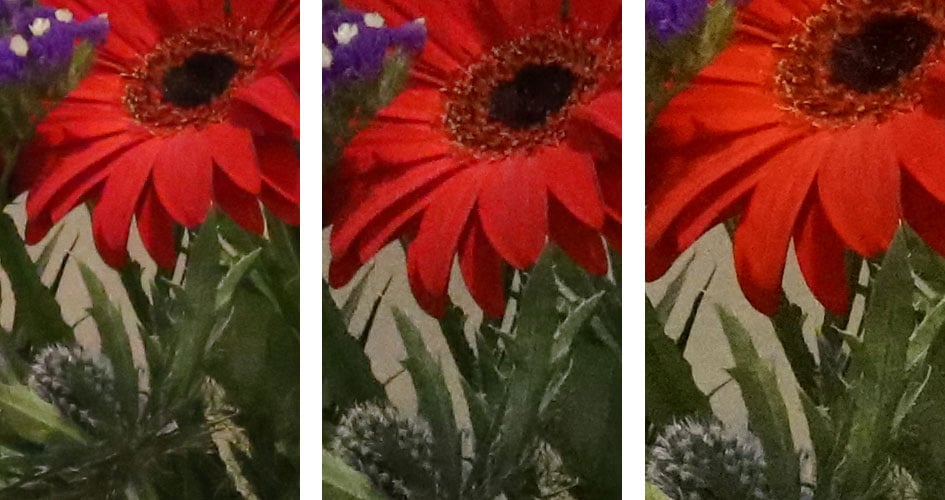
Above: Canon EOS 5D III (left), Canon EOS 5D IV (middle), Sony A7r II (right) all in JPEG at 12800 ISO
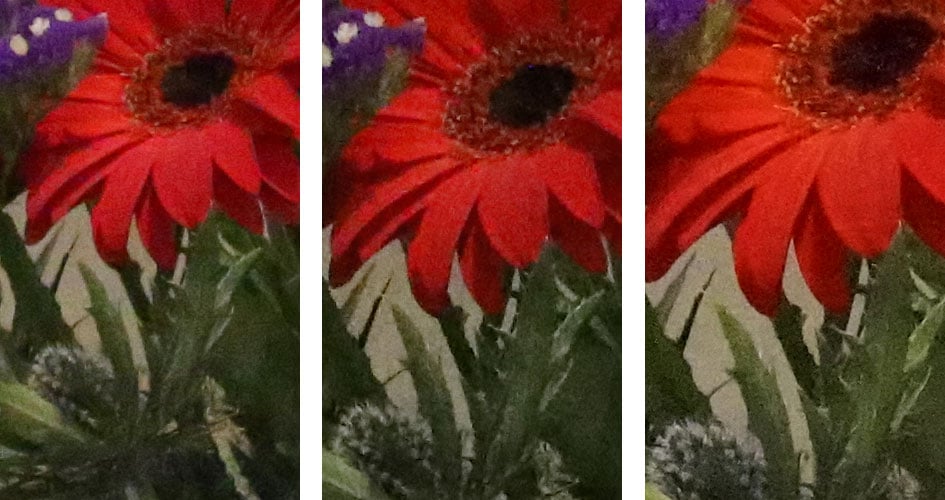
Above: Canon EOS 5D III (left), Canon EOS 5D IV (middle), Sony A7r II (right) all in JPEG at 25600 ISO
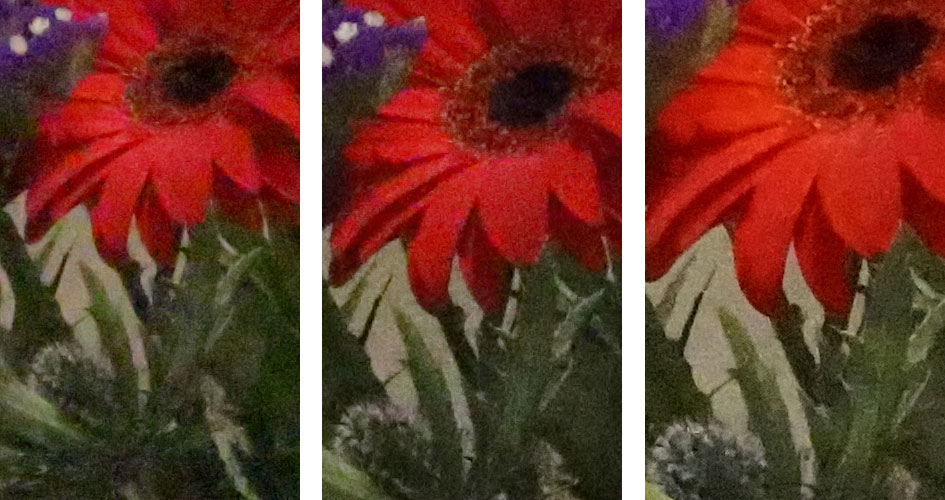
Above: Canon EOS 5D III (left), Canon EOS 5D IV (middle), Sony A7r II (right) all in JPEG at 51200 ISO
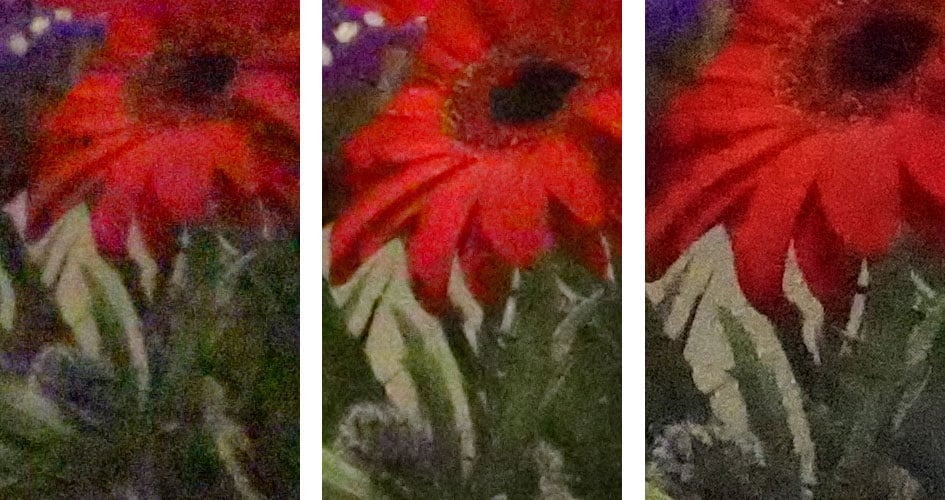
Above: Canon EOS 5D III (left), Canon EOS 5D IV (middle), Sony A7r II (right) all in JPEG at 102400 ISO
Next see the EOS 5D Mark IV against two modern APS-C bodies, the Fujifilm XT2 and Sony A6300. Scroll down to see how they compare!
Fujifilm XT2 vs Sony Alpha A6300 vs Canon EOS 5D Mark IV noise
To compare noise levels in low light I shot the following still-life arrangement with the Fujifilm XT2, Sony Alpha A6300 and Canon EOS 5D Mark IV at each of their ISO sensitivities. I fitted each body with a high quality prime lens: the Fujinon XF 35mm f2, Sony FE 35mm f2.8 and Sigma ART 50mm f1.4. On their APS-C bodies, the first pair were capturing an equivalent field of view of 53mm, so to match the field of view with the full-frame Canon at 50mm, I positioned it slightly closer.The two APS-C bodies were set to f8 and the full-frame to f11, and each sensitivity used exactly the same exposure. I disabled Auto lighting Optimiser on the Canon and Dynamic Range Optimiser on the Sony and used their standard picture styles and Auto White Balance. I shot all the images in RAW+JPEG mode and as soon as the Mark IV is supported in Adobe Camera RAW, I’ll present a comparison using identical processing settings. For now though, I’m presenting a comparison using the out-of-camera JPEGs, with the cropped region indicated by the red rectangle on the main image below; each is presented in the table below at 100%. Many thanks to Park Cameras UK for their support in making this comparison.

In the table below you’re looking at 100% crops made from two bodies with 24 Megapixel APS-C sensors and one with a 30.4 Megapixel full-frame sensor; from left to right, the Fujifilm XT2 (24 Megapixel APS-C X-Trans III), Sony A6300 (24 Megapixel APS-C Exmor CMOS), and Canon EOS 5D Mark IV (30.4 Megapixel full-frame CMOS). The Canon offers extended sensitivities of 50 and 102400 ISO, but I’ve left them off this comparison and just used the full range of the Fujifilm and Sony bodies from 100 to 51200 ISO.
The first thing to note is the Sony A6300 captured slightly brighter images which, given identical lighting and exposures, suggests it’s slightly more sensitive than the other two at the same quoted ISO values.
Looking beyond the brightness to the detail in the out-of-camera JPEGs and they’re all a lot closer than you might think, at least in the low to mid ISO range. Indeed I’d say they’re essentially delivering the same degree of real-life detail within this range and the only real difference – minor though it is – regards processing styles at the default settings.
At 3200 ISO and above, the impact of noise becomes more apparent on all of them, whether through softened details, increased speckles or smearing. At 3200 and 6400 ISO I’d say the Sony A6300 and Canon 5D IV enjoy a minor edge over the out-of-camera JPEGs from the Fuji XT2, but again it’s pretty subtle.
At 12800 ISO, there’s noticeable smearing in areas of flat colour, most notably resulting in lost detail in the leafs. Interestingly I’d say the Fuji now enjoys the edge over the Sony, but I wouldn’t cite the Canon 5D IV as being decisively better than either of the APS-C models, despite the benefit of a larger sensor. Sure there’s arguably a tad fewer noise speckles on the crops at 25600 and 51200 ISO, but nothing really significant. This might surprise you if you were assuming a definitive lead from full-frame over APS-C, but modern sensors keep getting better and the latest generation from Fujifilm and Sony are certainly very good.
Of course we’re not just comparing sensors here, but out-of-camera JPEG processing too using the default settings. I shot this scene in RAW+JPEG mode, so as soon as Adobe supports the EOS 5D Mark IV, I’ll be able to make a comparison with identical processing to level the playing field. But for now in terms of out-of-camera JPEGs, all three cameras are performing similarly in the 100-1600 ISO range with only minor differences beyond there.
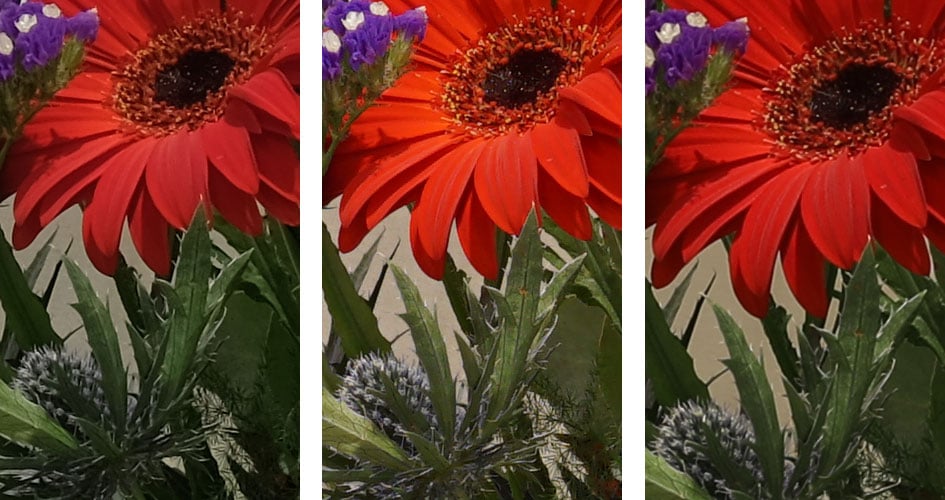
Above: Fujifilm XT2 (left), Sony Alpha A6300 (middle), Canon EOS 5D IV (right) all in JPEG at 100 ISO
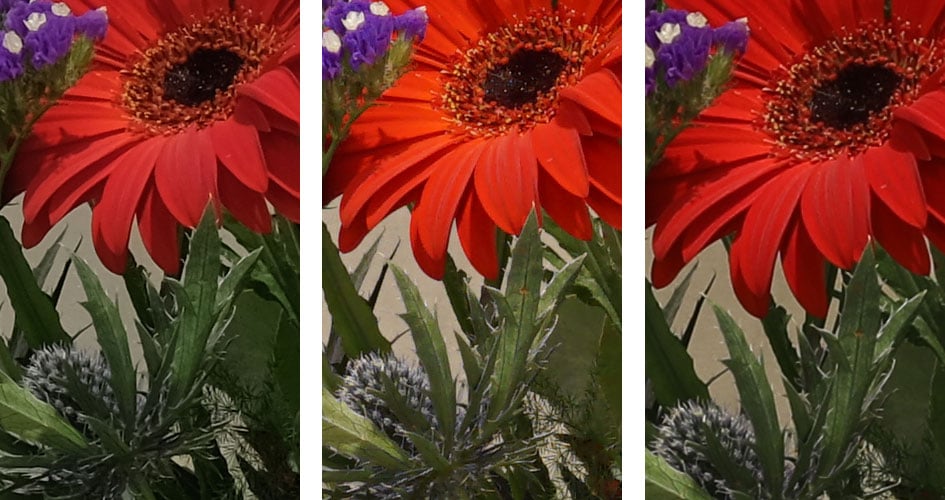
Above: Fujifilm XT2 (left), Sony Alpha A6300 (middle), Canon EOS 5D IV (right) all in JPEG at 200 ISO
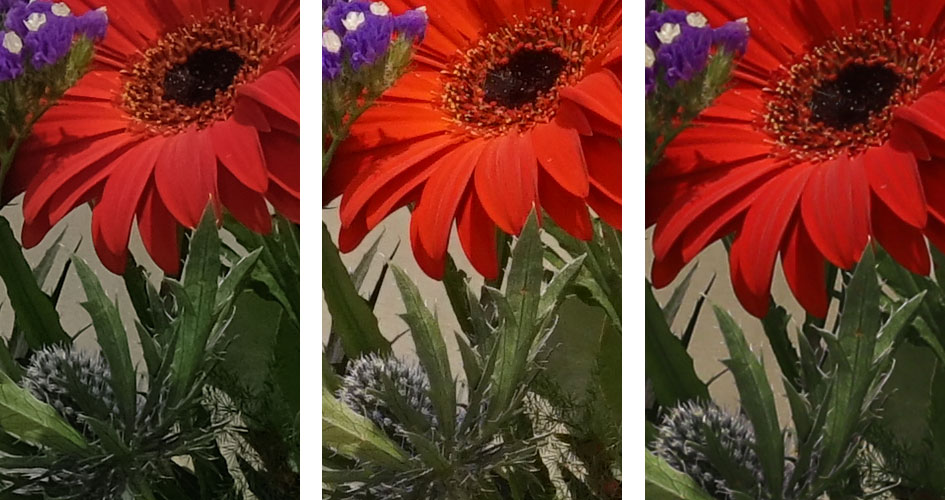
Above: Fujifilm XT2 (left), Sony Alpha A6300 (middle), Canon EOS 5D IV (right) all in JPEG at 400 ISO
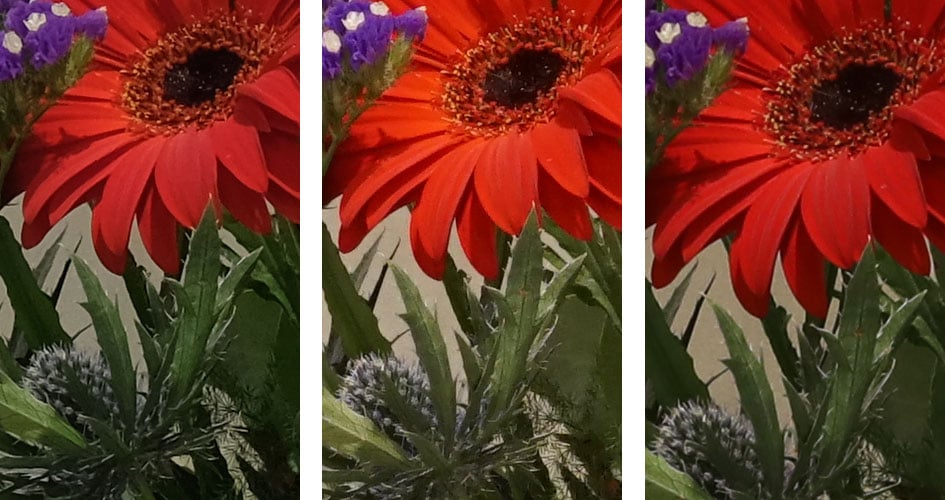
Above: Fujifilm XT2 (left), Sony Alpha A6300 (middle), Canon EOS 5D IV (right) all in JPEG at 800 ISO
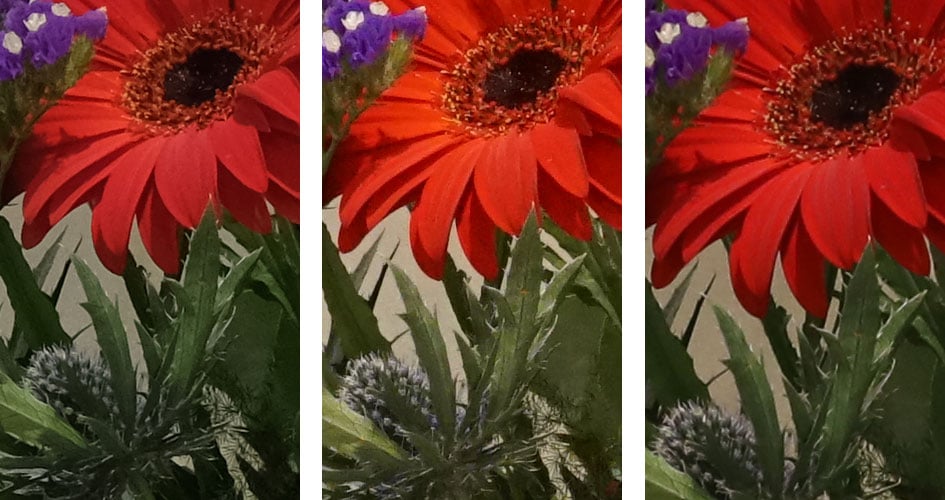
Above: Fujifilm XT2 (left), Sony Alpha A6300 (middle), Canon EOS 5D IV (right) all in JPEG at 1600 ISO
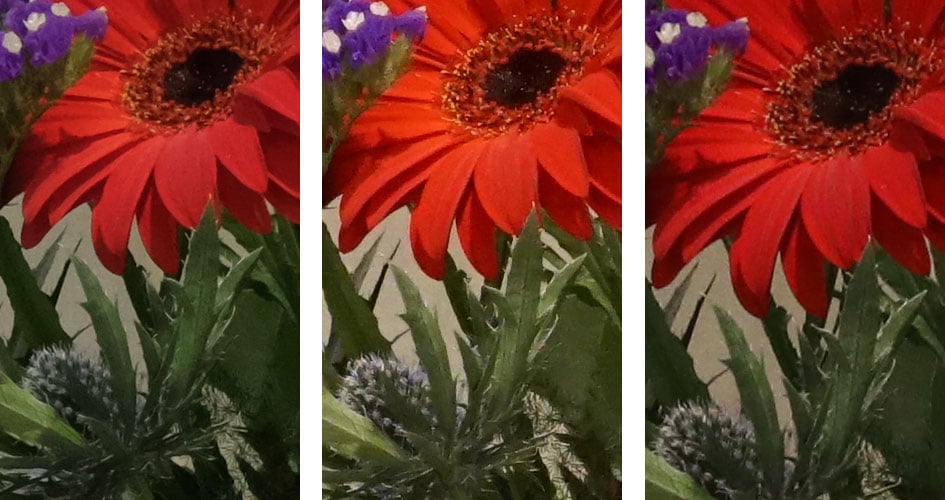
Above: Fujifilm XT2 (left), Sony Alpha A6300 (middle), Canon EOS 5D IV (right) all in JPEG at 3200 ISO
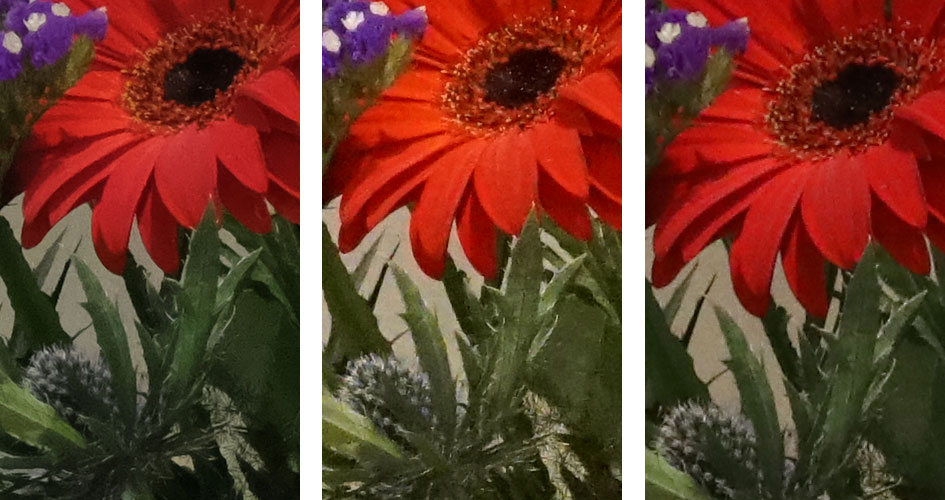
Above: Fujifilm XT2 (left), Sony Alpha A6300 (middle), Canon EOS 5D IV (right) all in JPEG at 6400 ISO
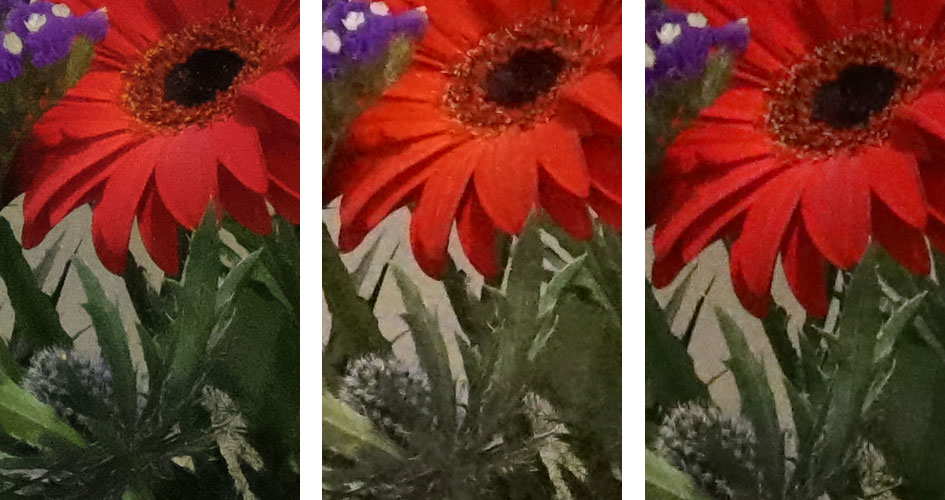
Above: Fujifilm XT2 (left), Sony Alpha A6300 (middle), Canon EOS 5D IV (right) all in JPEG at 12800 ISO
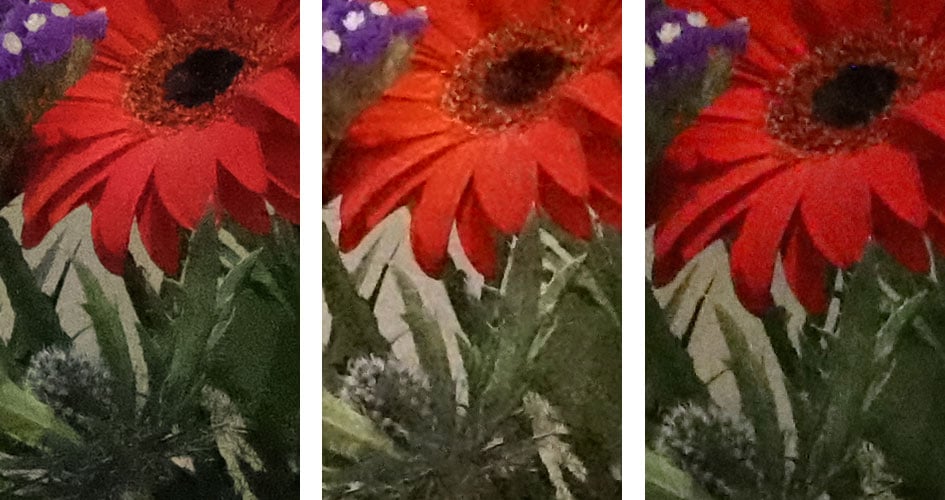
Above: Fujifilm XT2 (left), Sony Alpha A6300 (middle), Canon EOS 5D IV (right) all in JPEG at 25600 ISO
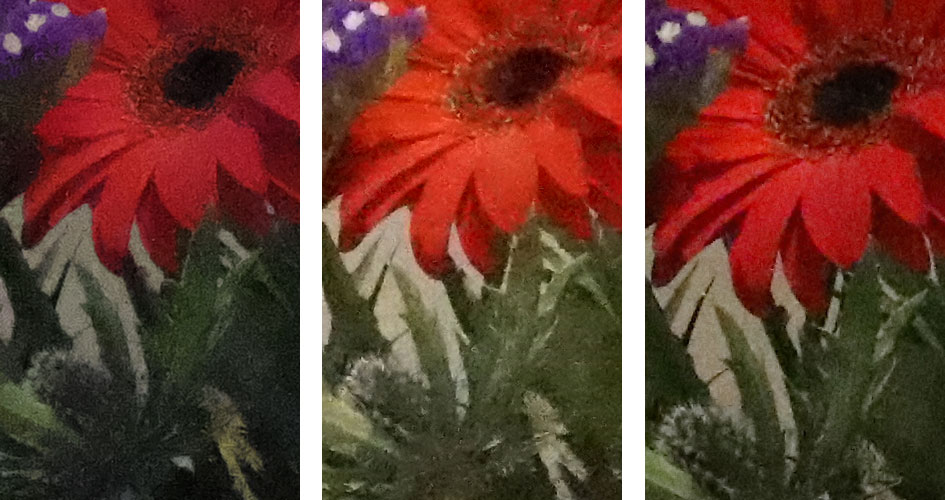
Above: Fujifilm XT2 (left), Sony Alpha A6300 (middle), Canon EOS 5D IV (right) all in JPEG at 51200 ISO
Next skip to my Fujifilm XT2 sample images, or scroll down for my earlier X-Pro2 vs XT1 noise comparison, the results of which apply to the XT2.
Next check out my Canon 5D Mark IV movie quality.
Fujifilm XT2 vs Sony A6300 vs Canon EOS 5D Mark IV movie quality in 4k
To compare 4k movie detail and noise levels in low light I shot the following still-life arrangement with the Canon EOS 5D Mark IV, Fujifilm XT2 and Sony A6300. It may seem odd to compare a full-frame DSLR against a pair of mirrorless cameras with smaller APS-C sensors, but the 5D Mark IV actually takes a crop when filming 4k that’s roughly similar in size to APS-C. So with similar sensor areas devoted to 4k capture and similar field-reductions as a result, I feel it’s a valid and important comparison to make. I matched the vertical field of view on each camera then filmed clips under (UK / 50Hz) artificial light at 25p, adjusting the white balance manually to 3200K. The picture profiles were set to their defaults and any noise reduction or tonal enhancements disabled. I then took frame-grabs of each clip using VLC and have presented crops at 100% in the table below.
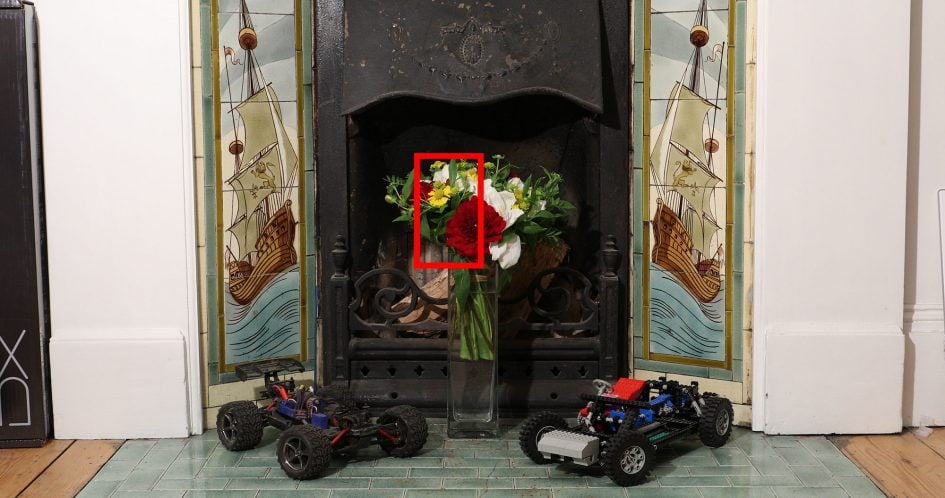
Each camera may be devoting a roughly similar sensor area to 4k capture, but with quite different numbers of pixels within it. The 5D Mark IV for example is using a 1:1 crop with no scaling, whereas both the Fujifilm XT2 and Sony A6300 are having to down-sample a higher resolution to generate a 4k frame. In the absence of RAW recording on all three or the ability to output 4k over HDMI on the Canon, I’m having to compare footage that’s already been processed in-camera using the default picture styles and profiles. Indeed judging from the crops below, the biggest difference between them regards their processing styles.
Starting on the left column, the Fujifilm XT2’s standard Provia Film Simulation is applying the highest contrast and sharpening for the punchiest result. In the middle column, Sony’s A6300 arguably has the mildest style of the three, while on the right, the Canon EOS 5D Mark IV has the softest style. In terms of actual detail recorded, I’d say all three are roughly in the same ballpark, although most graders would want to choose a calmer profile on the XT2 and apply greater sharpening to the Canon.
While all three start with roughly similar detail at 800 ISO, by 6400 ISO the noise levels have increased to a point they need to be dealt with. The Fuji and Canon clips become softer, while the Sony A6300 adopts a more hands-off approach with more visible noise but greater retained detail as a result. Indeed I’d say the A6300 delivers the best result here, but that for most of the range all three bodies are pretty close to each other.
This is an interesting result as it proves there’s little to no benefit of having the 5D Mark IV’s full-frame sensor when it comes to filming 4k video. The small crop effectively brings it in-line with APS-C models in terms of 4k quality, and while models like the Sony A6300 may lack a touch-screen and headphone jack, they make up for it with an articulated screen, the chance to film and review using the viewfinder, log profiles and 4k output over HDMI. Plus the small matter of being considerably smaller, lighter and cheaper.
But the 5D Mark IV does use its full sensor width when filming 1080p, so does that mean it might enjoy an advantage on noise levels over the APS-C models? To find out I filmed a second set of clips in 1080 / 25p and have presented crops in the second table below. Scroll down to check it out, or head over to my head over to my Canon EOS 5D Mark IV sample images or check out my verdict!
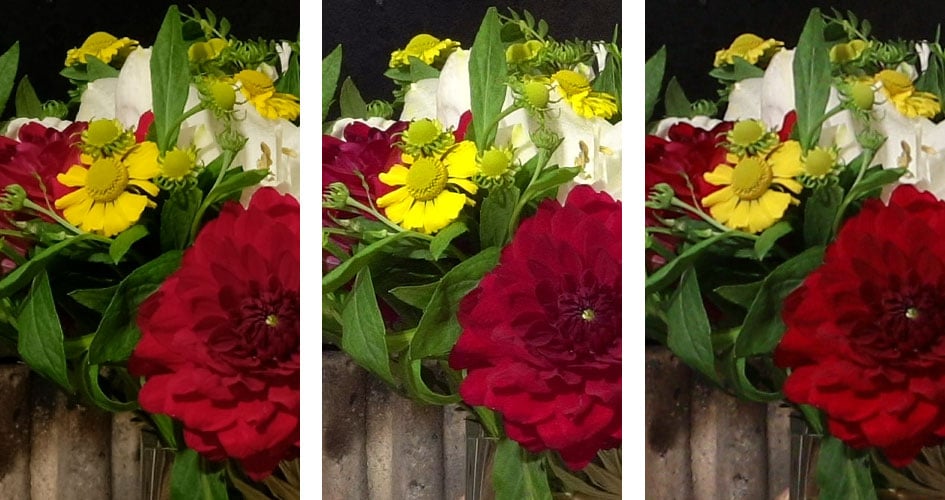
Above: Fujifilm XT2 (left), Sony A6300 (middle), Canon EOS 5D IV (right) all in 4k / 25p at 800 ISO
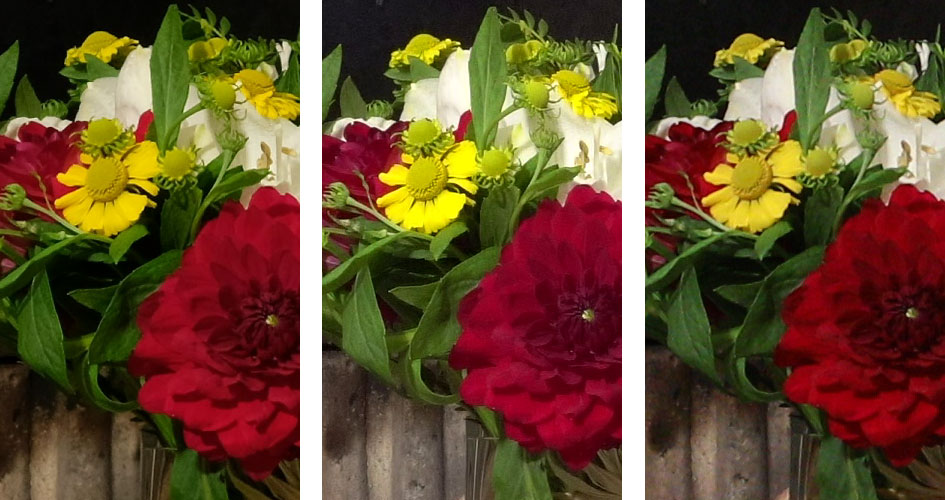
Above: Fujifilm XT2 (left), Sony A6300 (middle), Canon EOS 5D IV (right) all in 4k / 25p at 1600 ISO
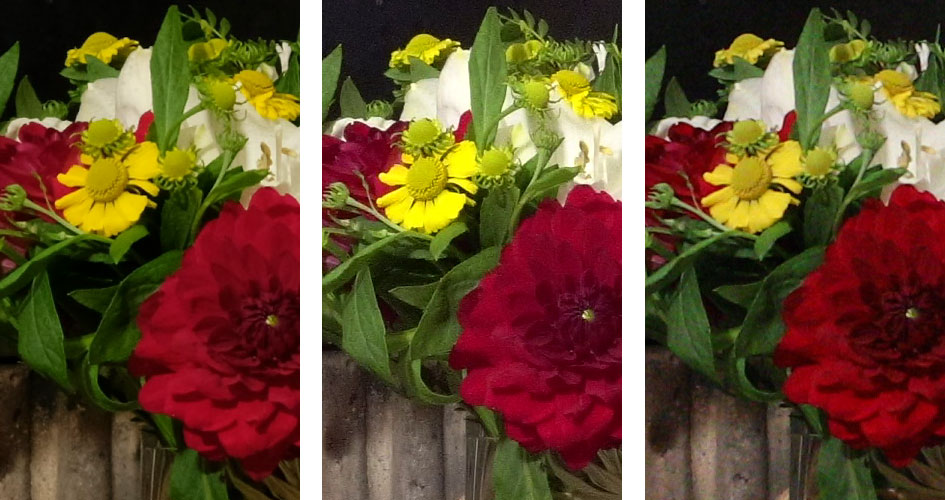
Above: Fujifilm XT2 (left), Sony A6300 (middle), Canon EOS 5D IV (right) all in 4k / 25p at 3200 ISO
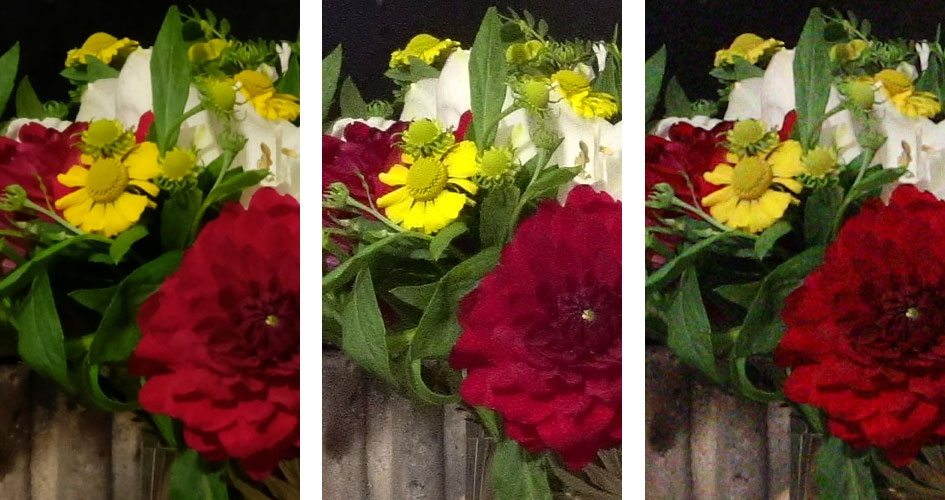
Above: Fujifilm XT2 (left), Sony A6300 (middle), Canon EOS 5D IV (right) all in 4k / 25p at 6400 ISO
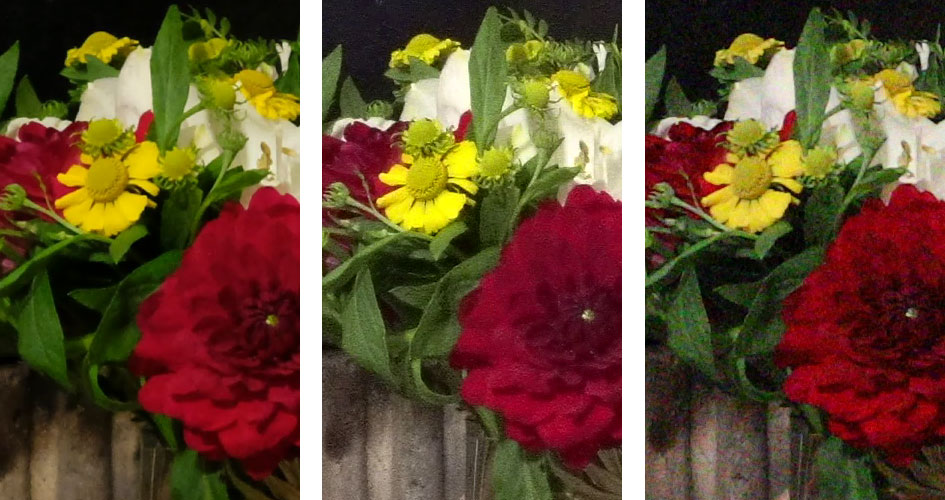
Above: Fujifilm XT2 (left), Sony A6300 (middle), Canon EOS 5D IV (right) all in 4k / 25p at 12800 ISO
Fujifilm XT2 vs Sony Alpha A6300 vs Canon EOS 5D Mark IV movie noise in 1080p
To compare 1080p movie detail and noise levels in low light I shot the following still-life arrangement with the Canon EOS 5D Mark IV, Fujifilm XT2 and Sony A6300. I matched the vertical field of view on each camera then filmed clips under (UK / 50Hz) artificial light at 25p, adjusting the white balance manually to 3200K. The picture profiles were set to their defaults and any noise reduction or tonal enhancements disabled. I then took frame-grabs of each clip using VLC and have presented crops at 100% in the table below.
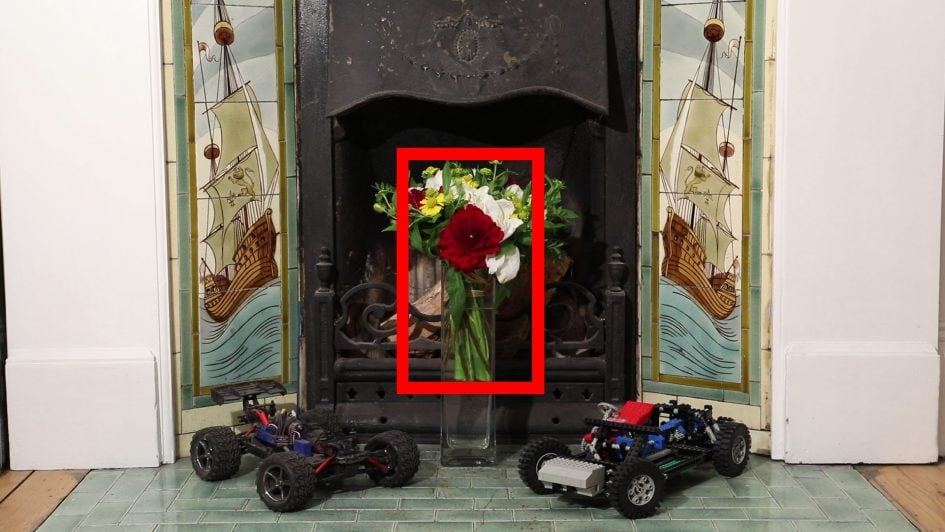
When filming 1080p, all three cameras use their full sensor widths and scale the pixels to generate a 1080 frame. But while the Fujifilm XT2 and Sony A6300 start with APS-C sized sensors, the Canon 5D Mark IV starts with a larger full-frame sensor. Since the original sensor resolutions aren’t too far apart, does this mean the Canon enjoys an advantage on noise levels? Let’s find out!
Judging from the crops below, each camera’s default processing is playing a significant role with Fujifilm again looking crispest and Canon the softest, but I’m confident that selecting more neutral profiles and processing to taste would deliver similar styles. Despite the greater sharpening and contrast to start with though, I feel the Fujifilm XT2 is actually capturing fractionally higher detail than the other pair, and I also fail to see any significant benefit in cleanliness to the Canon.
So for 1080p I’d give the Fujifilm XT2 the nod here, although again all three are pretty close. What it does however illustrate again though is a modern APS-C mirrorless camera can deliver essentially the same movie quality as a modern full-frame DSLR – at least in terms of resolution and noise levels. Of course there are perspective and depth-of-field differences to weigh-up when filming 1080 on the Canon as it does exploit the full sensor area, but again it’s revealing how the detail and noise aren’t decisively better.
Next head over to my Canon EOS 5D Mark IV sample images or tab back to my verdict!
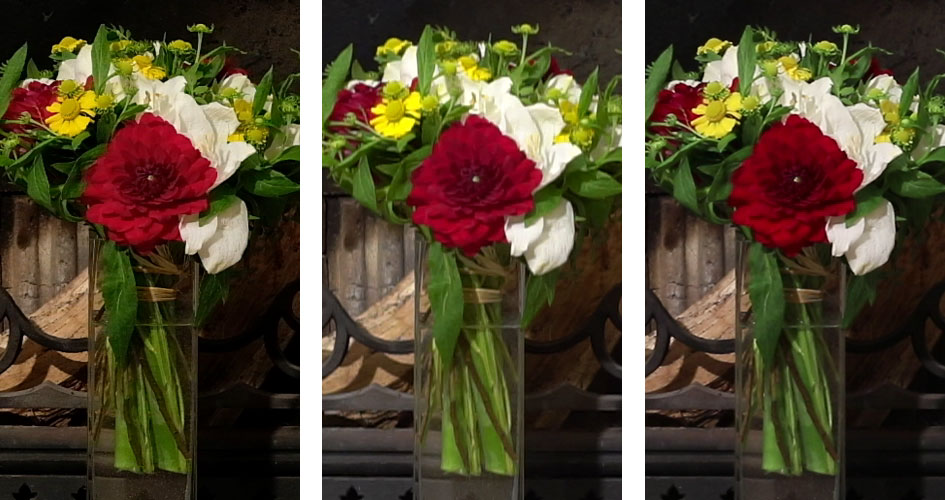
Above: Fujifilm XT2 (left), Sony A6300 (middle), Canon EOS 5D IV (right) all in 1080 / 25p at 800 ISO
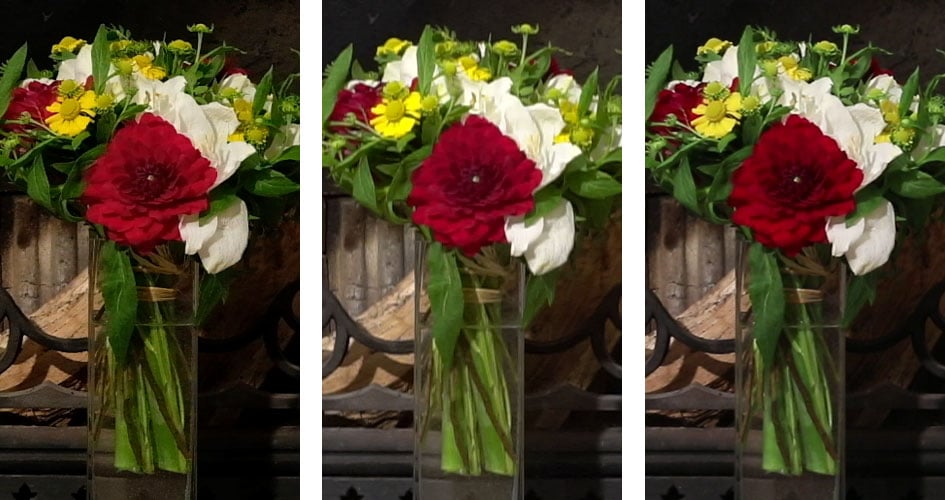
Above: Fujifilm XT2 (left), Sony A6300 (middle), Canon EOS 5D IV (right) all in 1080 / 25p at 1600 ISO
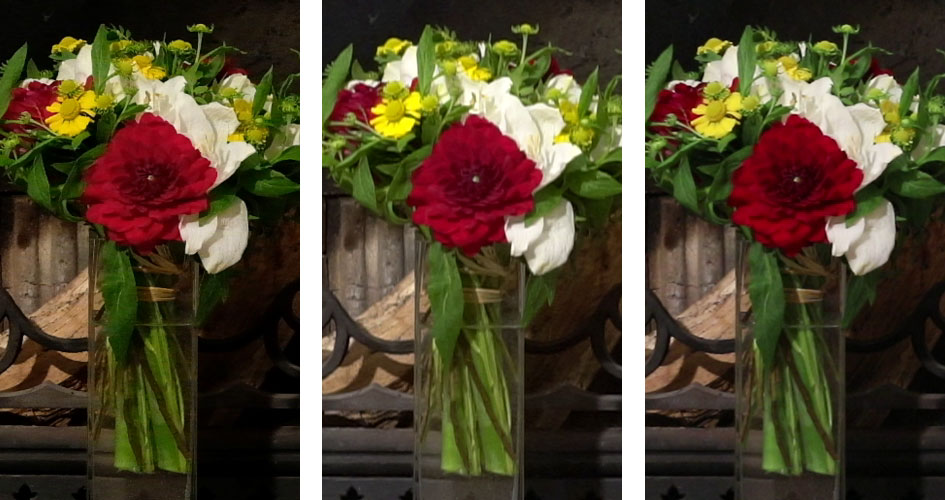
Above: Fujifilm XT2 (left), Sony A6300 (middle), Canon EOS 5D IV (right) all in 1080 / 25p at 3200 ISO
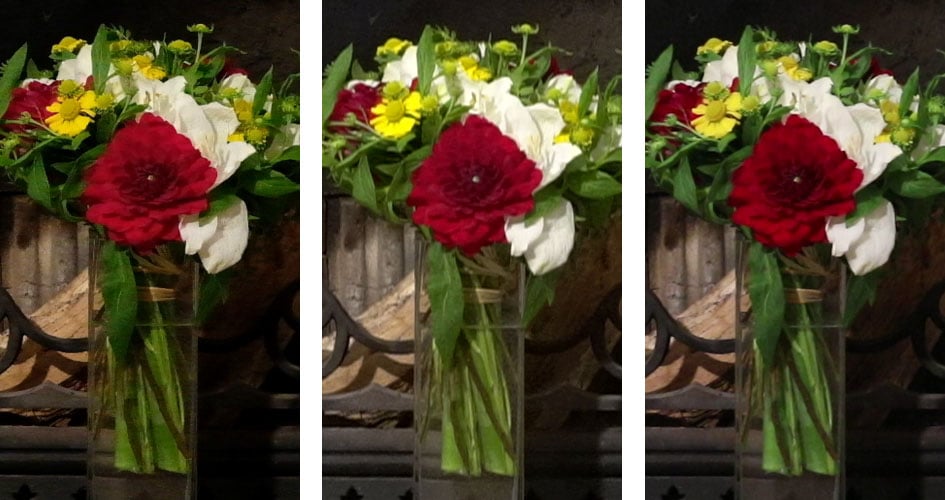
Above: Fujifilm XT2 (left), Sony A6300 (middle), Canon EOS 5D IV (right) all in 1080 / 25p at 6400 ISO
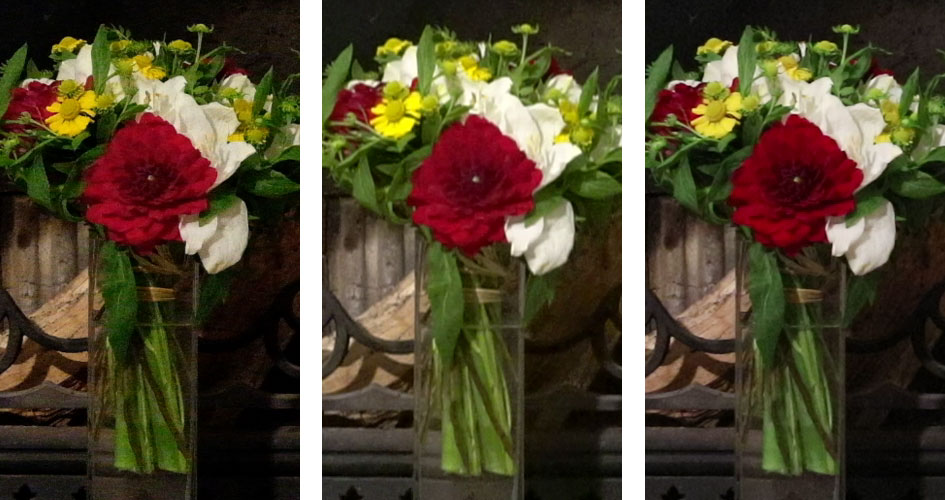
Above: Fujifilm XT2 (left), Sony A6300 (middle), Canon EOS 5D IV (right) all in 1080 / 25p at 12800 ISO
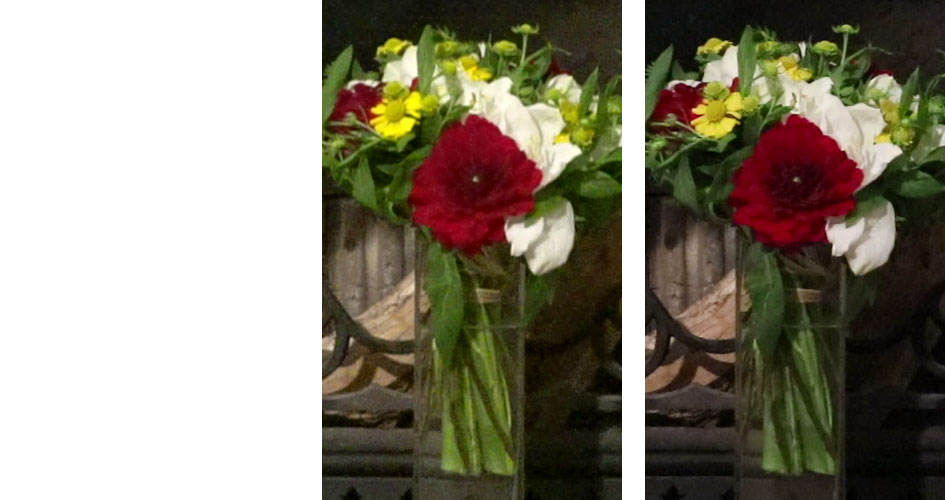
Above: Fujifilm XT2 (left), Sony A6300 (middle), Canon EOS 5D IV (right) all in 1080 / 25p at 25600 ISO
Next tab over to my sample images or back to my verdict!
Check prices at Amazon, B&H, Adorama, eBay or Wex. Alternatively get yourself a copy of my In Camera book, an official Cameralabs T-shirt or mug, or treat me to a coffee! Thanks!




